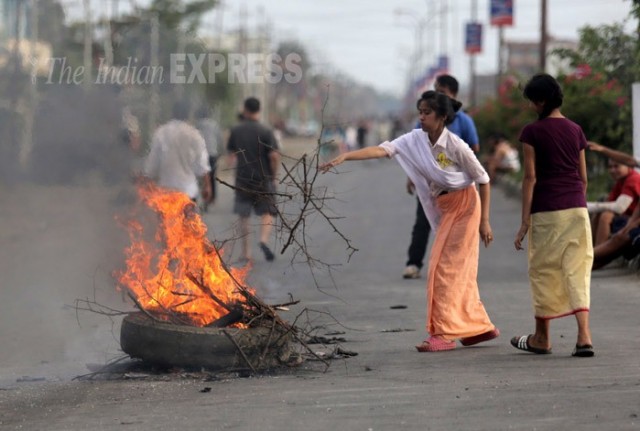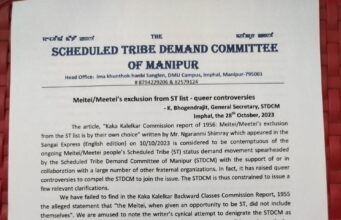By Mutum Yoiremba
In the wake of the ILP related protests at various parts of Manipur, irrespective of the hill valley dichotomization of politics and applying it to all people’s movement, there are some thoughts we could have a serious look at. One of the most important thought is to see through the stupidity of a movement led by leadership and organization based politics. In doing so, I wish to provide a few and simple suggestions to the readers of this write up. In the recent burning of tires and tree branches, beating up of passers-by, I see a pristine opportunity for the people to really wake up and make decisions themselves. If there is really an opportunity to practice the concept called “democratic struggle”, this is it! One way of looking at the incidents of burning and the beating, is the people putting thought into practice and generating anti-authoritarian self legitimacy.
For those who want to generate an anti-people’s movement, this will hurt you the most. At one layer, the formation of violence seems to be sporadic. And this has been the basis of countering popular movements of the people in Manipur by many reactionaries. It has been argued that violence on the streets is an effect of drunkards, drug addicts and vagabonds of localities all around in Manipur; that the violence is just nuisance created by ruffians. Nothing could be more perverse than this belief. If we really care to look deeper into this “violence at the street”, we can see that there are different layers to decode violence. One such is to see the body as the site of violence and not the streets, and another to look into the triangular set up of Law, Representation and Democracy.
The shrinkage of the space of political enactment corresponds to the expansion of the acting subject—the increasing correlation of personhood to historical transformation. This is something Allen Feldman brought out in “Formations of Violence” through his study of war torn Belfast, Northern Ireland in 1991.And this is an understanding I vouch for in order to strip down violence on the streets of Manipur to its nakedness. If we really locate violence spatially, the body is the real site of political violence enacted by various levels of hegemonic powers; whereas, the streets are just theatres to see acts of violence. An act, no matter how much theatrical a performance, does not bring out the wholeness of an acting subject; an act only entails certain roles. So rather than the act itself, the acting subject is something we can focus to decode violence.
We are deeply enmeshed in a whirlpool of structurally instituted political violence, from unemployment to domestic violence and from insurgency-counterinsurgency operations to corruptions. It would be a mistake to consider unemployment and poverty as a simple failure of policy implementations, while on the other hand instituting violence at the street as real violence and isolated from the structural violence. What is in fact burning of tires and beating of passers-by is a manifestation of the structurally instituted violence which is expressed in another form by the acting subject. The so called drunkards and ruffians, in their act of violence on the streets are challenging the norms of legality and definition of violence itself. As Partha Chatterjee would agree that the politics of the governed starts with the governed defining themselves the way to be governed, it is the politics of the subaltern to engage with the political society dominated by the elites. These “street hooligans” of Manipur are on the brink of even going beyond just defining the way to be governed, to actually governing themselves through the art of street violence.
In a political society such as ours, dominated by elitist liberal bourgeoisie concept of legality, representation and vague democracy, the street hooligans are the real heroes. In the shrinking spaces of political enactment they are the real acting subject. Whereas places like GM hall and Iboyaima Shanglen are dominated by mouthpiece of law interpreters, representative leaders, and firm believers in electoral democracy, our street hooligans are actually challenging this triangular set up of law, representation and democracy through acts of non-legality, self representation and actual democratic struggle. In the absence of clear enemy or target, however they are slipping into unconcealed religious, ethnic-cultural hatred and targeting of passers-by. These could only mean the failure of a representative politics of the leaders who have failed to channelize the burst of anger born out as a result of structurally instituted violence. The acting subjects in their acts of violence on the street while being liberating are also acquiring the techniques of domination, which is really self-destructing like a snake devouring itself from its tail.
So now the task is how to develop further the liberating elements and do away with the self-destruction. Our learned representatives and intellectuals of the movement could maybe able to channelize the anger on the streets, not just by representing them in meetings and public debates or in the discourses of legality of the movement but by becoming an organic whole with subaltern politics of violence at the street. So instead of trying to define the movement, maybe the movement could give an opportunity to define the representatives instead, making it two way traffic for ideas and it’s implementation. So, the “representatives of the people” should actually escape what I call the Non-Bermuda triangle suction by the nexus of law, the politics of representing others and of electoral notions of democracy; and maybe they could be a lot more than just being generators and censors of protests deciding how and when to protest. If we really begin to decode violence on the streets, the enactment of organized violence is not the street hooligans but the men in green and the reactionaries who tries to take away space for political enactment. Decoding the violence at the streets, it then turns out to be a war between the subalterns and elites. What the Non-Bermuda triangle does is assimilate and de-radicalize social movement, where the politics adapt to the service of the liberal bourgeoisie and resistance becomes futile. The violence of the street hooligans who beats up passers-by and burn tires and trees is just the implosion of the Non-Bermuda triangle of law, representation and vague democracy of electoral politics. But let us not altogether denounce violence, because to denounce violence as a tool to challenge an inherently violent political structure is to preserve the status quo. After all, how do we transpose vulnerability of the subalterns and the elites without violence? The people’s movement cannot really be confined and categorized into just the demands for and against ILP, an unconscious part of the movement really seem to be directing towards transposition of vulnerability. This transposition is making even the powerful state and its machineries vulnerable. So this is a real democratic struggle in its true essence, it has through collective yet autonomous acts of the agencies, abilities to shake power at its foundations.
So, this is an attempt to engage a political dialogue with everyone who is reading this. So now, why shouldn’t we realize new ways of protests? Why can’t we direct and channelize the anger to the ones we should really be angry with? Why can’t we, at this opportune moment realize who really is the people’s enemy? How democratic is electoral bourgeoisie democracy? And how undemocratic is the street violence? These are just subjective and ambiguous questions I would like to throw open to the all in hope to engage in the discourse of protest and violence as a tool of engagement in political society by the subalterns and as a weapon of the weak. We have been just shucked by electoral politics all the time which has in its essence representation and never self rule. But the ways I see it, the violence at the street by the acting-subjects are raising new politics of self governing sovereigns and entails a powerful democratic force that could topple the elitist politics and rising liberal bourgeois representative democracy in Manipur. As for ILP, to implement it we don’t need a piece of paper the law sanctions; we can do ILP like we do violence at the streets by self representation in political enactment.













Lougi matam oire louda kumnarase arembada matam manghalaroisi kumgi nongna thamhouradi sarak sani chingmigidi season leite chahi amada numit 365 thabak sunangai lei,houjikti kamdoure eikhoina sumangi protest haona delhi da eikhoina delhi da protest touradi haona u s a da c di masana tabani hainingai leitrabagi haosingdi christian oibagi u s a na support toubanidum hainare thainadagi mangal phangningladi jesu thajou hairingei dadi haogi laini hairamlaga houjik ti eikhoi hao/tribe oirage haibase yamna ekainingaini nasa phahaningladi sagoldo maning hanhallo haibagumbani.